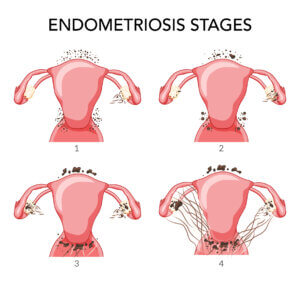Learn about how doctors categorize stages of endometriosis
 If you have been diagnosed with endometriosis, you may have heard your doctor categorize your severity of it in stages. Staging is useful for your physician in determining disease burden and management. Knowing the stage of endometriosis helps your doctor in planning treatments, especially if you are seeking to get pregnant.
If you have been diagnosed with endometriosis, you may have heard your doctor categorize your severity of it in stages. Staging is useful for your physician in determining disease burden and management. Knowing the stage of endometriosis helps your doctor in planning treatments, especially if you are seeking to get pregnant.
Staging of endometriosis requires surgery
Endometriosis can be difficult to diagnose because there is no reliable, non-invasive way to accurately diagnose it. An ultrasound exam can provide clues, but the majority of endometriosis lesions occurs on the peritoneal surfaces and cannot be accurately seen on ultrasound. These peritoneal surfaces include everything in your abdominal cavity, including the intestines, stomach, liver, uterus, fallopian tubes and ovaries. Laparoscopic surgery is required to visualize and, if necessary, biopsy the lesions.
Physicians categorize endometriosis by number, size, location and depth
At the time of surgery, endometriosis is staged according to the number and size of the lesions found, where they’re located and how deep they are in the tissues. Your surgeon can visualize lesions and severe adhesions due to endometriosis during laparoscopic surgery. This minimally invasive surgery allows direct visualization of the peritoneal cavity, ovaries, outside of the tubes and uterus by using a laparoscope with a small camera.

- Stage I (minimal): Lesions are small and superficial, meaning they’re close to the surface of the tissues. There may not be any scar tissue, or it is minimal.
- Stage II (mild): More lesions that tend to be located deeper inside the tissue. There might be scar tissue, but there isn’t usually inflammation present.
- Stage III (moderate): Numerous deep endometrial implants are found and there can be endometrial cysts in at least one of the ovaries which are commonly called endometriomas or chocolate cysts. These cysts form when implants attach to the ovary leaving behind old brown blood which collects within a capsule. An endometrioma can grow and rupture which can result in very severe pain. Thin bands of endometrial scar tissue can fuse organs together.
- Stage IV (severe): Many deep endometrial adhesions found typically located on the fallopian tubes and bowels. There may also be numerous large cysts on the ovaries, but they can also be found behind the uterus and rectum. These cysts can cause abdominal pain, constipation, nausea, and painful bowel movements along with significant pain with urination and intercourse.
The stage of endometriosis does not correlate with pain or response to infertility treatment
Interestingly, the stage of endometriosis does not correlate at all to the severity of pain a woman experiences. Among asymptomatic women who present with infertility, the proportion that have endometriosis at laparoscopy ranges from 9-50% (average around 30%) and the majority (70% or more) have small amounts of disease, typically in the minimal and mild stages. On the flip side, stage I endometriosis is considered “minimal,” but it doesn’t mean you won’t have pain or symptoms.
The stage of endometriosis also does not predict your response to therapies for infertility. The majority of studies show that infertile women with Stages I-II endometriosis have virtually the same chances of successful conception with fertility therapy as infertile women without endometriosis.


